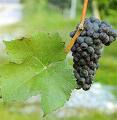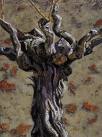Last week I moderated a panel at the annual conference held in California’s Central Coast called ‘World of Pinot Noir,’ at Domaine Alfred in the Edna Valley. The idea of the seminar was to  compare old vine / old clone Pinot Noir with young vine / young clone Pinot Noir, and we had a terrific group of winemakers who brought wines from each category to compare and discuss. In two hours we were able to examine just a few aspects of what is a fairly complicated, multi-dimensional subject. What follows is a transcript of my introductory remarks, as well as an overview of what we discussed.
compare old vine / old clone Pinot Noir with young vine / young clone Pinot Noir, and we had a terrific group of winemakers who brought wines from each category to compare and discuss. In two hours we were able to examine just a few aspects of what is a fairly complicated, multi-dimensional subject. What follows is a transcript of my introductory remarks, as well as an overview of what we discussed.
I’ve written about my history with old vines previously on Wine Review Online. I was able to retell the story of my life in southern France, where I had a somewhat romantic existence, living hand to mouth for as long as I could hold out, struggling to write a completely unpublishable novel. This was in the Languedoc departement known as l’Herault, in a tiny village called Montpeyroux, where one spring afternoon I encountered a small old vineyard with stunted bush vines planted in what could charitably be called a rockpile. The vines there wore the struggle of their existence in the burls, knots and twists in their ancient limbs.
Here are those introductory remarks:
 Of course these old vines, as old as they were, had learned how to handle the indignities of an impoverished soil far better than young vines. Like most living things with a few years under the belt, they had learned a thing or two, namely, how to adapt to their surroundings.
Of course these old vines, as old as they were, had learned how to handle the indignities of an impoverished soil far better than young vines. Like most living things with a few years under the belt, they had learned a thing or two, namely, how to adapt to their surroundings.
It is far-fetched to call this wisdom; nevertheless, in a romantic’s mind, that’s a very easy conclusion to make. Looking at an old vineyard is like looking at an old painting, or an old building. It can’t help but fill you with wonder–and if you love wine, you can’t help but want to taste what comes from it.
I imagine that each of the winemakers on the panel started from an analogous romantic position, that the romance of what’s in the glass–whether it’s from old vines or young–instilled in them a yearning to make the stuff, to take part in that great, mysterious transformation from vine to wine.
But each of them realized that in order to provide themselves, and us, with the seeds of romantic yearning, and of wonder, they would have to master the most technical, and clinical of topics, clones.
It is hard to imagine the word ‘clone’ and the word ‘romantic’ in the same sentence. There is the miracle of birth, and there is the very ignoble prospect of copying a living thing so that it is bears an exact likeness of the original. The very notion of cloning is a little creepy.
But clones are the very practical answer to a very vexing problem that winegrowers encountered hundreds if not thousands of years ago: vines planted from seed tended to vary wildly from plant to plant, and from generation to generation. Cloning sought to regain control, and to isolate the very best fruit. And in isolating selections, the earliest winemakers, in effect, established battle lines for heated discussions that continue to this day.
But for Pinot Noir, those discussions are all the more fervent. As John Winthrop Haeger writes in North American Pinot Noir, there are many good reasons for this:
The clones of Pinot Noir [he writes] inspire special passions. Pinot, by virtue of its genetic instability and its predisposition to spontaneous mutation, and perhaps also because it seems to be more susceptible to certain viral diseases, which may trigger intravarietal mutation–this is a controversial point–displays a very broad range of phenotypes. [You notice how easy it is to slip into a scientific frame of mind, speaking of clones.]
Several hundred clones of Pinot Noir are thought to exist. Adjacent vines of Pinot Noir in the same vineyard, to say nothing of vines in different vineyards, if they were not propagated from the same mother vine, can be very different. They can bud earlier or later; ripen earlier or later; flower more or less reliably; produce grape clusters that are smaller or larger, tighter or looser; produce berries with thicker or thinner skins; and (perhaps most important) make wines that taste quite different. Acutely conscious of this variation, the contemporary Pinot grower pays enormous attention to choosing, planting, and propagating the ‘right’ clones for each site.
Clonal selection is a relatively recent obsession of grapegrowers and winemakers. Not that long ago just a handful of Pinot clones were in play in the U.S., some originating from France, some from Switzerland, some from Germany, some from France by way of UC-Davis, and a few propagated by thoughtful, far-thinking Pinot producers like Joseph Swan, Louis Martini, Martin Ray, and Paul Masson; still other cuttings were brought into the country under dark of night in suitcases from the famed vineyards of Burgundy–if you believe all the stories, every single one of these cuttings has originated from Domaine de la Romanée Conti–those guys really need to put up a fence.
A storied name like DRC certainly lends some much-needed allure to something so anonymous as a clone. But needless to say, planting DRC clones hasn’t produced clones of Domaine de la Romanée Conti–not by a long shot. As brilliant, as consistent, and as specific as clones are, they are only one part of the vast matrix of factors that leads one from the vine to the bottle. Rootstocks, yeasts, barrel regimes, and above all, site, contribute as well. And clones, after all, amount to just one brilliant attribute, like a cello with one string: it’s a beautiful timbre, but it may end up sounding pretty boring after a while.
Winemakers add texture and harmony by blending clones together. And clones themselves add to their resonance by getting older–I believe that the most interesting aspect of today’s discussion will be talking about the adolescents–the new clones, with a little bit of age. Who knows, maybe in a few years, the vines that we find are the most beautiful, the ones that fill us with wonder, will be the new clones we’re all talking about now.
* * *
We are a long way from understanding these fully. If anything, even after hundreds of years of informal study, we’re still on the climbing end of the curve. But it’s an exciting time to take an evaluative look at things. And my panelists–winemakers Myron Redfern of Amity Vineyards, in Oregon, Eric Hickey of Laetitia Vineyards, Ken Bernards of Ancien Vineyards, Nathan Glazer of Thomas Fogarty Winery, Milla Handley of Handley Cellars, and Dan Goldfield of Dutton Goldfield Winery–were eager to address the task.
The range of clonal selections that my panelists looked at were  roughly from two camps–the old plantings consisted of clones developed by Louis Martini, Joseph Swan, and a French Pommard clone popular in Oregon; the new vines were, nearly all of them, planted to a new class known collectively as Dijon clones.
roughly from two camps–the old plantings consisted of clones developed by Louis Martini, Joseph Swan, and a French Pommard clone popular in Oregon; the new vines were, nearly all of them, planted to a new class known collectively as Dijon clones.
There are some worthwhile generalizations to make about how these two classes grow and operate in the vineyard–young vines, generally, are precocious, grow faster, produce more sugar (and alcohol), and since they grow faster, tend to be a little simpler at the outset. Old vines, on the other hand, set a very reliable crop, and their growth cycle tends to be slower and more even. The new clones developed in Dijon–they go by very mundane names–not even names really, but numbers: 115, 116, 667, 777, etc.–are more efficient, more free of disease, and not terribly complex. But what they lack in complexity they make up for in exuberance, brightness, and purity of fruit expression.
Beyond this, it was hard to make too many generalizations, except to say that it wasn’t a good idea to make generalizations. To take just one example: the Martini clone in the vineyards of Laetitia in the Arroyo Grande Valley produced entirely different flavors than the Martini clones at Thomas Fogarty in the Santa Cruz Mountains.
There was, however, a textural similarity: both had a firm spiciness, a tackiness to their texture, that suggested a kinship–maybe it was the thickness of the skin, or the crop-level, or the clone, or the age of the vines. All of these could be said to be true–so where was the similarity coming from? Laeticia’s Eric Hickey said he believed it was the clone talking; he believes that vine age might be the most difficult thing to detect in a finished wine.
All agreed that the Dijon clones were the current fashion–they were like the new kids at the high school, and everyone had to check them out. But checking them out in a vineyard amounts to a huge commitment, an investment of time and property, and there’s no telling what sort of results you’ll get. More than this, the vines change as they get older, as they adapt to their surroundings. Dan Goldfield made the observation with his Martini clone vineyards that after a certain point (beyond, he guessed, about twenty years) it was probably inaccurate to call the clone Martini at all, since the vines had probably changed genetically over the course of decades. Certainly Dijon clones, so energetic and flashy in their youth, are likely to settle with some vine age.
As for the old clones, it seems likely that they’ll find their way back into fashion. Their quality is the reason they’ve hung around this long in the first place. Allen Meadows, who writes the highly respected journal Burghound, mentioned from the audience that in Burgundy, artisanal producers have abandoned new clones altogether and are returning to the traditional cane planting process of propagation called selection massale, thereby ensuring that the site itself will dictate clonal selection in the decades, and the generations to come.
